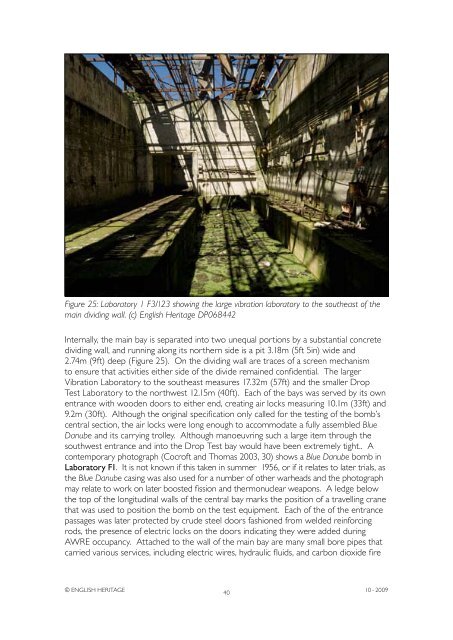Atomic Weapons Research Establishment. Orford ... - English Heritage
Atomic Weapons Research Establishment. Orford ... - English Heritage
Atomic Weapons Research Establishment. Orford ... - English Heritage
You also want an ePaper? Increase the reach of your titles
YUMPU automatically turns print PDFs into web optimized ePapers that Google loves.
Figure 25: Laboratory 1 F3/123 showing the large vibration laboratory to the southeast of the<br />
main dividing wall. (c) <strong>English</strong> <strong>Heritage</strong> DP068442<br />
Internally, the main bay is separated into two unequal portions by a substantial concrete<br />
dividing wall, and running along its northern side is a pit 3.18m (5ft 5in) wide and<br />
2.74m (9ft) deep (Figure 25). On the dividing wall are traces of a screen mechanism<br />
to ensure that activities either side of the divide remained confidential. The larger<br />
Vibration Laboratory to the southeast measures 17.32m (57ft) and the smaller Drop<br />
Test Laboratory to the northwest 12.15m (40ft). Each of the bays was served by its own<br />
entrance with wooden doors to either end, creating air locks measuring 10.1m (33ft) and<br />
9.2m (30ft). Although the original specification only called for the testing of the bomb’s<br />
central section, the air locks were long enough to accommodate a fully assembled Blue<br />
Danube and its carrying trolley. Although manoeuvring such a large item through the<br />
southwest entrance and into the Drop Test bay would have been extremely tight.. A<br />
contemporary photograph (Cocroft and Thomas 2003, 30) shows a Blue Danube bomb in<br />
Laboratory F1. It is not known if this taken in summer 1956, or if it relates to later trials, as<br />
the Blue Danube casing was also used for a number of other warheads and the photograph<br />
may relate to work on later boosted fission and thermonuclear weapons. A ledge below<br />
the top of the longitudinal walls of the central bay marks the position of a travelling crane<br />
that was used to position the bomb on the test equipment. Each of the of the entrance<br />
passages was later protected by crude steel doors fashioned from welded reinforcing<br />
rods, the presence of electric locks on the doors indicating they were added during<br />
AWRE occupancy. Attached to the wall of the main bay are many small bore pipes that<br />
carried various services, including electric wires, hydraulic fluids, and carbon dioxide fire<br />
© ENGLISH HERITAGE<br />
40<br />
10 - 2009

















